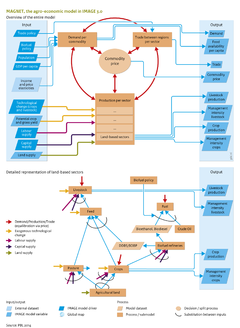Agricultural economy/Data uncertainties limitations: Difference between revisions
Jump to navigation
Jump to search
m (Text replace - "DataAndLimitation" to "DataUncertaintyAndLimitation") |
ElkeStehfest (talk | contribs) No edit summary |
||
| Line 2: | Line 2: | ||
|Status=On hold | |Status=On hold | ||
|Reference=Stehfest et al., 2013; Woltjer, 2011 | |Reference=Stehfest et al., 2013; Woltjer, 2011 | ||
|Description=<h2>Data<h2> | |||
The MAGNET model uses the GTAP8 database for sectoral input–output tables and bilateral trade in the reference year 2007 (Narayanan, Aguiar and McDougall, 2012). For agriculture, all GTAP sectors are used, while other industrial and service sectors are aggregated in MAGNET. The regional representation of GTAP is aggregated to match the IMAGE regions outside Europe, but within Europe data are kept at country level (appendix). For the start year, agricultural land use, for both arable land and permanent grassland, is based on FAO statistics; In addition, the model also uses a large number of essential coefficients, such as Armington trade elasticities, consumption function parameters, substitution elasticities for all production nests, CET elasticities for land-use transformations, and elasticities in the land supply curve. Some parameters are based on econometric research or economic literature, while others are no more than ‘best guesses’ (Woltjer et al. 2011). The autonomous technological yield change in MAGNET and IMAGE is based on FAO projections (Bruinsma 2003). | |||
===Uncertainties=== | |||
Systematic uncertainty analyses of models on the agricultural economy, including the MAGNET model, to date, have not been conducted. A comparison between the LEITAP (now MAGNET) and IMPACT models revealed large differences in model results, even more in policy scenarios than in baseline projections (Stehfest et al. 2013). A recent model intercomparison within AgMIP included 10 global agro-economic models, using harmonised scenario drivers. Preliminary results from this comparison indicate that MAGNET is in the upper range of other models, in terms of future land-use expansion (Von Lampe, et al., Nelson et al., both forthcoming). This is probably due to the rather large land supply in MAGNET, which allows further expansion of agricultural land, most notably in North and South America and Africa. In contrast, several other models do not explicitly consider agricultural land expansion, but only allow interchanges between, for example, arable land and grassland. In addition to land supply, the most relevant uncertainties in the MAGNET model are those of autonomous technological change, relative contribution of intensification or expansion to total production growth, retaining current trade patterns in long-term scenarios, dynamics in the livestock sector, especially with respect to pasture area and grassland intensification (Stehfest et al. 2013), and long-term dietary preferences. The poor empirical basis of many of these parameters in MAGNET and all other agro-economic models needs to be improved (Hertel 2011). | |||
===Limitations=== | |||
The MAGNET model provides a complete and internally consistent picture of the world economy, covering all economic sectors, and a dynamic modelling of all primary and intermediate production and demand. One important limitation, which is hardly known, is the uncertainties in constructing the GTAP\MAGNET database, as many ad-hoc assumptions need to be made in order to fill the database; for example, on allocating value added between different inputs. Furthermore, the volumes in the model are not expressed in physical terms but in monetary values. Likewise, all substitutions in the model are on the basis of monetary values. As a consequence, there is no guarantee that changes in composition are consistent with the physical requirements, such as in livestock feed, and therefore a closer link to physical units is necessary (Woltjer 2011). Because of the highly aggregated and general character of MAGNET, most elasticities are kept constant over time, though some improvements have been introduced in the consumption function. Armington elasticities are also constant, and therefore trade flows that are small in the starting year will never become large in the future. Although some of these limitations can be improved in the future by adding physical units and improving the empirical basis for the most important elasticities, many simplifications in agro-economic models will remain. The MAGNET model provides a consistent system to assess economy-wide effects of policy measures on land use, income, welfare and production, and helps policy makers and scientists to think about these complex interlinkages, but the simplifications and uncertainties that come with such a broad coverage need to be kept in mind when interpreting results. | |||
}} | }} | ||
Revision as of 17:34, 5 December 2013
Parts of Agricultural economy/Data uncertainties limitations
| Component is implemented in: |
|
| Related IMAGE components |
| Projects/Applications |
| Key publications |
| References |
